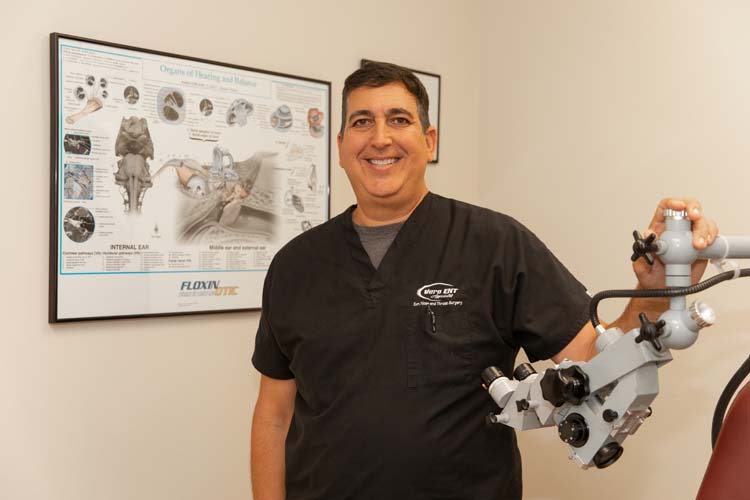
Eustachian tube dysfunction, or ETD, is a common and annoying condition that some people may have had for years without even knowing it.
The Eustachian tubes are small channels that run between the middle ear and the upper throat. Their job is to equalize ear pressure and drain fluid from the middle ear. When they’re not functioning properly, they can cause dulled hearing and a feeling of pressure or fullness that can last for days, months or even years.
Vero Beach Otolaryngologist Dr. Jeffrey Livingston says victims of the condition commonly experience “fullness or congestion or popping in their ears, or have something called baro-challenge, which is difficulty clearing their ears in certain situations like on an airplane flight or when scuba diving.
“There’s a large number of people,” Livingston continues, “who may have had it their entire life … [and until recently] we didn’t have a good solution for that problem.”
That’s the bad news about ETD.
The good news is a new and effective treatment has been approved by the FDA. It’s called the Eustachian tube balloon dilation system and Dr. Livingston is excited about it.
“This is first time we have a procedure to fix the Eustachian tube,” the ear, nose and throat specialist says, “and this can be a permanent fix as opposed to just temporizing by ventilating the ears.”
Giving the CliffsNotes version of the new procedure, Livingston explains that the lower part of the Eustachian tube has “a kind of cartilaginous lining. When we inflate this balloon, it compresses the mucosa and causes it to resurface or reline. That causes [the lining] to flatten and helps the tube become more open.”
“I had a patient recently,” Livingston continues, “who told me that her ears had felt full for 30 years. We did this procedure and now her ears feel perfect. She was really thankful and I was thankful that I had something I could offer her. Last year or two years ago I’d have had to say, ‘I’m sorry. There’s not much I can do about this.
“It’s great to have something that’s minimally invasive and low-risk that can actually solve a problem. It’s a home run in my book.”
Before this balloon dilation system became available, medical treatment options were limited to what Livingston calls “topical nasal steroid sprays like Flonase or Nasacort,” or topical decongestants, like Afrin, Sudafed or Neo-Synephrine, or inserting tubes into the ear. But those solutions were – at best – temporary. And sometimes downright annoying.
Livingston says that inserting artificial tubes sometimes “made the ear sound echo-y,” a condition called autophony, but the new treatment does not have that side effect.
Duke Health backs up Livingston’s high opinion of the newly-approved procedure. It says “inserting a small, balloon-like device in a blocked Eustachian tube may bring lasting relief to the millions of children and adults who suffer from chronic Eustachian tube dysfunction each year. Duke ear nose and throat doctors … say it has the potential to significantly reduce the need for ear tubes and other ear surgeries.”
Meanwhile, ENT Today, a publication of the Triological Society of American and the American College of Surgeons, says “a study of 100 Eustachian tube dilations with follow-ups over two years showed a 70-percent success rate.”
“I’m excited about this ear procedure,” says the general and pediatric ear, nose and throat and endoscopic sinus surgery specialist. “There’s nothing better. All I want to do is have my patients do well, minimize the degree of risk and maximize the degree of success. Those are things that I love doing.”
Dr. Jeffery Livingston is with Vero ENT at 1325 36th Street, Suite A in Vero Beach. The phone number is 772-563-0015.



